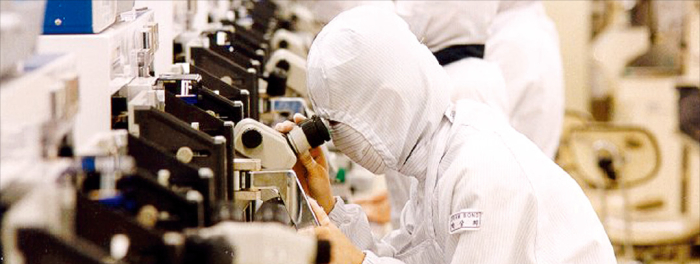R&Ds
Chips, EV and AI lead Korean firms' 2020 R&D spending
By Apr 05, 2021 (Gmt+09:00)
3
Min read
Most Read
LG Chem to sell water filter business to Glenwood PE for $692 million


Kyobo Life poised to buy Japan’s SBI Group-owned savings bank


KT&G eyes overseas M&A after rejecting activist fund's offer


StockX in merger talks with Naver’s online reseller Kream


Mirae Asset to be named Korea Post’s core real estate fund operator



Despite the spread of the global pandemic, slightly more than half of the 100 largest companies spent more on R&D than 2019, with a focus on future growth drivers including aerospace and renewable energy, according to the regulatory Financial Supervisory Service (FSS) on Apr. 4.
Their 2020 R&D expenditure in total marks a 3.7% increase from a year earlier, accounting for 2.2% of total sales, unchanged from the previous year's. The 100 companies were based on 2019 sales, among those listed either on the country's main bourse, or the junior stock market. State-owned companies and financial companies were excluded.
R&D spending by Korean firms is expected to pick up further this year, with the big businesses setting their sights on new growth drivers, as their current mainstay areas are slowing down in revenue growth amid the contactless trend. A generational leadership change at family-owned conglomerates over the past few years prompted their advance into new territory.
Hyundai Mobis Co., an automobile parts supplier, joined the ranks of companies with over 10 trillion won in R&D spending, driven by its heavy investments in self-driving technology and in-vehicle infotainment components such as audio, video and navigation systems.
South Korean companies with over 1 trillion won in R&D spending in 2020:
| Company |
R&D spending |
| Samsung Electronics | 21.2 trillion won |
| LG Electronics | 4.0 trillion won |
| SK Hynix | 3.5 trillion won |
| Hyundai Motor | 3.1 trillion won |
| LG Display | 1.7 trillion won |
| Kia | 1.7 trillion won |
| Naver | 1.3 trillion won |
| LG Chem | 1.2 trillion won |
| Hyundai Mobis | 1.0 trillion won |
| Source: FSS | |
By business group, the top four names -- Samsung, Hyundai Motor, SK and LG -- took a vast majority of the spending, or slightly over 80%, at 41.1 trillion won. Samsung Electronics alone made up 43%. The world's largest memory chipmaker's R&D expenditure in 2020 set a record for a fourth consecutive year since 2017.
"We have been investing in new businesses such as AI and automotive parts, along with investments in the semiconductor to maintain a wide lead over rivals," said a Samsung source.
Among other conglomerates, Hanwha, POSCO and Hyosung groups are accelerating their push into future growth areas. In particular, Hanwha Aerospace Co. poured 462.4 billion won into R&D, or 8.7% of sales. Its sister company Hanwha Solutions Co. spent 124.8 billion won on its solar technology. The two Hanwha units and affiliate Hanwha Corp were among the top 10 Korean companies with the highest R&D ratios against sales.
Last year, POSCO spent 21% more on R&D at 655.3 billion won than a year before as the country’s largest steelmaker is fostering battery materials for EVs as its next growth engine.
In terms of R&D spending versus revenues, Naver, an internet giant in Korea, has allocated a quarter of its sales to R&D per year since 2017. That is a high percentage level even compared to global counterparts such as Google Inc. and Amazon.com.
Companies with high R&D ratios:
| Company | R&D expense to revenue ratio (%) |
| Naver | 25.1 |
| Kakao | 12.9 |
| SK Hynix | 10.9 |
| Samsung Electronics | 9.0 |
| Hanwha Aerospace | 8.7 |
| Source: FSS | |
Companies with large year-on-year R&D spending growth in 2020:
| Company | Net increase vs 2019 |
| Samsung Electronics | 1,021.5 billion won |
| SK Hynix | 293.4 billion won |
| Naver | 236.2 billion won |
| POSCO | 113.8 billion won |
| Samsung SDI | 95.7 billion won |
| Source: FSS |
|
By contrast, 47 companies in the top 100 curtailed R&D budget in 2020 to concentrate on saving their businesses in the pandemic-stricken economy. In particular, Doosan Group saw the biggest year-on-year drop in R&D expenditures among the 100 companies, or a 160 billion won decrease, due to its liquidity constraints.
Write to Kyung-Min Kang at kkm1026@hankyung.com
Yeonhee Kim edited this article.
More to Read
-
 Paradigm shiftHydrogen, aerospace, materials: key words for Korean business leaders
Paradigm shiftHydrogen, aerospace, materials: key words for Korean business leadersApr 01, 2021 (Gmt+09:00)
4 Min read -
 Hanwha GroupHanwha launches group-wide task force to bolster space business
Hanwha GroupHanwha launches group-wide task force to bolster space businessMar 08, 2021 (Gmt+09:00)
2 Min read -
 Korea’s leading EV battery makers’ R&D spending hits record $1 bn in H1
Korea’s leading EV battery makers’ R&D spending hits record $1 bn in H1Aug 18, 2020 (Gmt+09:00)
3 Min read
Comment 0
LOG IN


